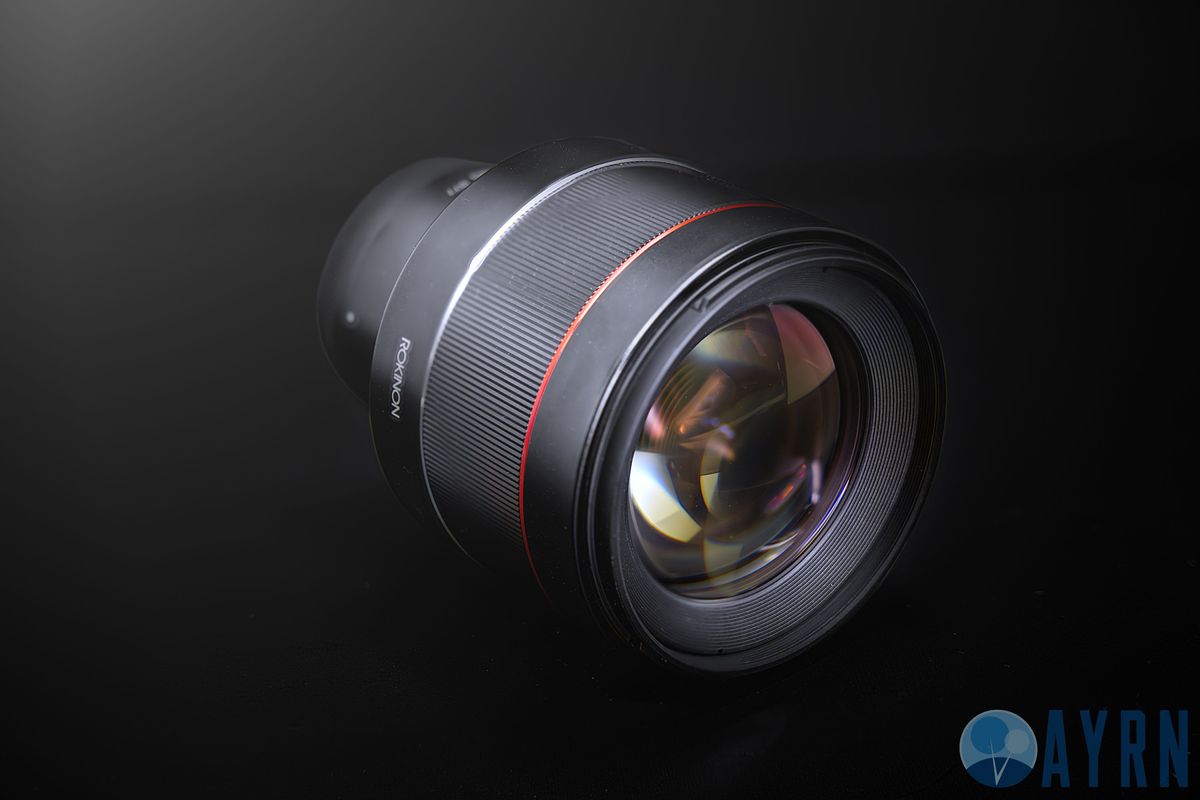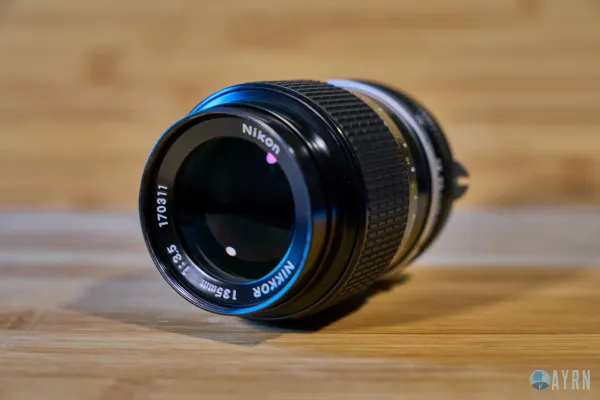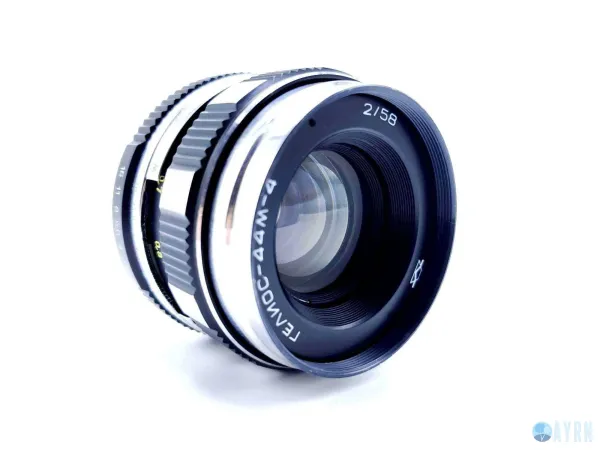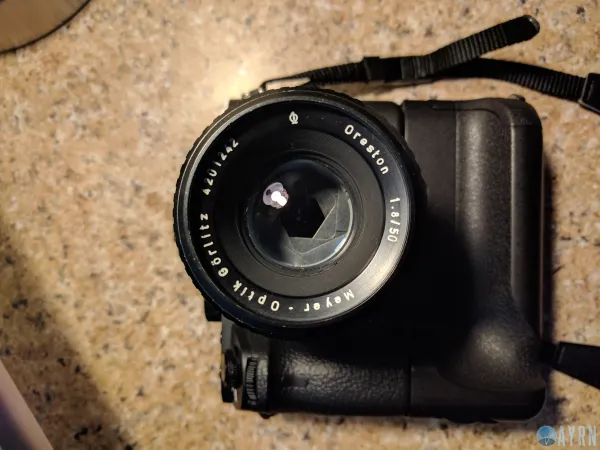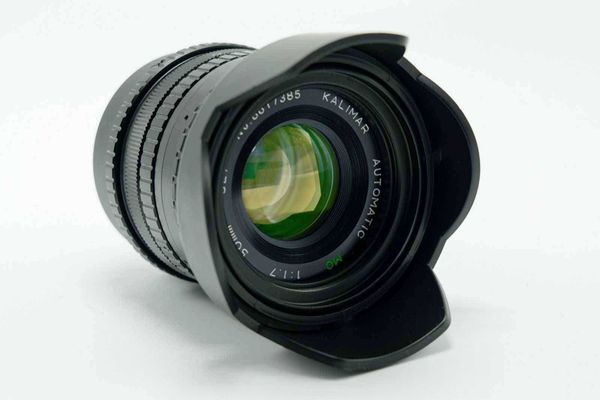This article contains affiliate links, for more information see the disclosure here. Using these links won't cost you a thing, may save you money, and it helps us to keep putting out great material for you to read while remaining ad free. Thanks for your support!
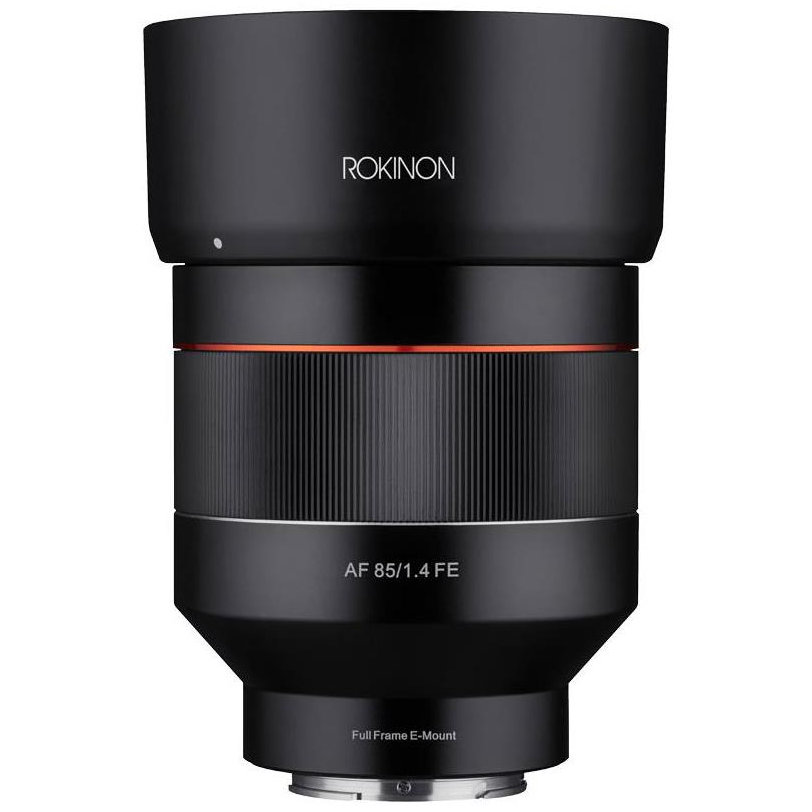

About
Of all the wallet friendly 85mm lenses we've tested so far, the Rokinon AF 85mm f/1.4 for Sony is our absolute favorite, and for that, it gets our Kudos Award. If dreamy bokeh, razor sharp subjects, snappy autofocus, and gorgeous contrast are what you're looking for, this lens is definitely worthy of serious consideration - especially when it currently comes at a price point that is nearly a third of the cost of Sony's 85mm f/1.4 GMaster, half the cost of Sigma's 85mm f/1.4 DG HSN Art, and significantly lighter than either of these other options.
Where to get it
Note: We purchased the Rokinon AF 85mm f/1.4 used in this review with our own money. This review is independent and is not sponsored by Samyang/Rokinon or endorsed by them in any way.
Pros and cons
Cons.
✕ No switches, buttons, or aperture ring
✕ Dock required for firmware updates
✕ Average autofocus in video
✕ Average build materials
Pros
✓ Ultra fast and bright
✓ Weather sealed
✓ Sony full-frame e-mount native
✓ The best 85mm bokeh we've tested
✓ Fantastic value
✓ Beautiful image quality
✓ Firmware updates via dock
✓ Fast, accurate autofocus
✓ Very light for an 85mm f/1.4 lens
Contents
Versus the alternatives
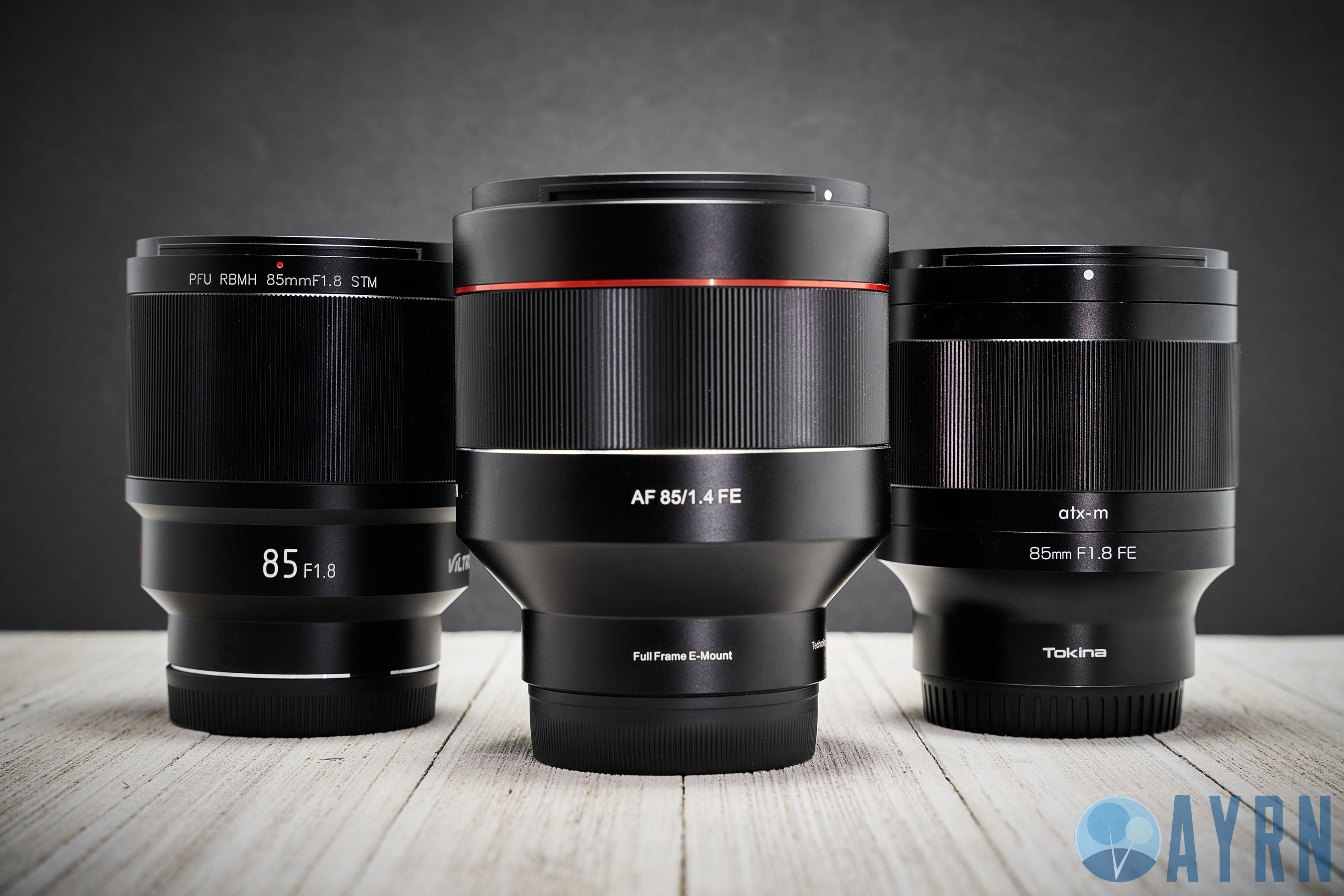
Tokina 85mm f/1.8 vs. Samyang/Rokinon 85mm f/1.4
Tokina's new 85mm f/1.8 is an excellent lens that runs about $100-$150 less than the Samyang/Rokinon we're reviewing. That said, it's slower, darker, not quite as sharp, and has more of an odd distortion pattern. The build materials of this lens are definitely denser and traditionally associated with high levels of quality, but in terms of my personal experience, if I had to make a bet, I'd put my money on the Samyang/Rokinon being more reliable out of the box and a more durable purchase in the long run. Autofocus is roughly on par with the Rokinon, but if I had to pick one, I'd say the Tokina is just a tad faster in this department. If your budget is tight, I'd say this is an excellent alternative option worth considering.
Rokinon 85mm f1.4
+ Faster and brighter
+ Lighter
+ Sharper
+ Creamier bokeh
+ Better contrast
+ Better micro contrast
+ Firmware updates
+ Weather sealing
Tokina 85mm f1.8
+ Cheaper
+ Metal body vs. plastic
+ 3-year warranty (vs. 1-year)
+ Equally good autofocus
Viltrox 85mm f/1.8 vs. Samyang/Rokinon 85mm f/1.4
In my experience, this Viltrox 85mm f/1.8, the mark ii version, and Tokina 85mm f/1.8 have virtually identical optics, so there will be some overlap here, although some features do differ. For example, Both Viltrox 85mm f/1.8 lenses have a port built into them for firmware updates. As of the time of writing this article, Tokina does not offer a dock for firmware udpates, although it is rumored that one will be made available, likely at an additional cost to users. That said, the Rokinon lens we tested bested Vtilrox in terms in much better contrast, micro-contrast, sharpness, bokeh and weight. Unlike the MK 2 version of the Viltrox 85mm f/1.8, there is currently a special firmware update for the MK i that unlocks a wider aperture of f/1.6, making it almost as bright and wide as Samyang's offering. The wider aperture comes at the cost of being slightly softer, making it significantly less sharp than the Rokinon at f/1.4.
Rokinon 85mm f1.4
+ Faster and brighter
+ Lighter
+ Sharper
+ Creamier bokeh
+ Better contrast
+ Better micro contrast
+ Firmware updates via dock
+ Weather sealing
Viltrox 85mm f1.8
+ Cheaper
+ Metal body vs. plastic
+ Nearly on par autofocus
+ Firmware upgradeable to f/1.6
+ Firmware update port
Viltrox 85mm f1.8 ii vs. Rokinon 85mm f1.4
The Mark ii version of this lens appears to be virtually identical optically to its first generation predecessor, but it comes with moderately improved autofocus that places it roughly on par with Rokinon's 85mm lens. You won't yet find any magical firmware update to upgrade the maximum aperture to f/1.6 on the mk ii, but you do have a built in firmware update port, which allows you to upgrade the lens without purchasing a dock, as with the Rokinon. While still heavier than the Rokinon, this lens is a bit lighter than its first iteration and comes with a nicer looking petal shaped lens cap. It's outshined by the Samyang in all the same ways that the original version is in terms of contrast, sharpness, micro-contrast, etc.
Rokinon 85mm f1.4
+ Faster and brighter
+ Lighter
+ Sharper
+ Creamier bokeh
+ Better contrast
+ Better micro contrast
+ Firmware updates via dock
+ Weather sealing
Viltrox 85mm ii f1.8
+ Cheaper
+ Metal body vs. plastic
+ Firmware update port
Rokinon 75mm f1.8 vs. Rokinon 85mm f/1.4
If portability and light weight are what you're looking for in a medium telephoto lens, nothing beats the new 75mm "tiny, but mighty" series lens from Rokinon/Samayng. While its compact size comes at the cost of a bit slower aperture, less creamy bokeh, a shorter (albeit much more unique) focal length, and a bit less sharpness (particularly acorss the frame). The light weight and compact size of this lens makes this a great choice for videography and the customizeable switch that allows you to use the focus ring to silently adjust the aperture is brilliant towards that end. This lens doesn't feature any sort of weather sealing though, so it's not as robust of a solution for shooting in the elements as the 85mm f/1.4 is. That said, it comes at a price point that's nearly hald that of the 85mm f/1.8, making it an incredible value.
Rokinon 85mm f1.4
+ Faster and brighter
+ Sharper
+ Creamier bokeh
+ Better contrast
+ Better micro contrast
+ Weather sealing
Rokinon 75mm f1.4
+ Much cheaper
+ Much lighter
+ Has customizeable switch
+ Better choice for video
Sony FE 85mm f/1.8 vs. Samyang/Rokinon 85mm f/1.4
People have been praising this Sony 85mm option for years now, and no wonder - it's an amazing lens! Its build quality is roughly on par with Samyang's as are its features. However, the Rokinon provides superior overall optical performance and, in my experience, seems to be a bit faster autofocus wise. For roughly the same price, Rokinon gives you a faster, wider aperture and all of the good things that come with it. Both lenses are weather sealed and both are quite light, although the Sony is significantly lighter than the Rokinon in this case. In its favor, the Sony currently seems to do a better job of continuous autofocusing for video than the Rokinon.
Rokinon 85mm f1.4
+ Faster and brighter
+ Sharper
+ Creamier bokeh
+ Slightly better contrast
+ Slightly better micro contrast
+ Better autofocus for stills
Sony FE 85mm f/1.8
+ Cheaper
+ Lighter
+ Better continuous autofocus in video
+ Firmware update port
Zeiss Batis 85mm f/1.8 vs. Samyang/Rokinon 85mm f/1.4
While significantly more expensive, this lens is a bit better in terms of contrast and micro-contrast and delivers on the legendary colors and pop that Zeiss is famous for in a way that no other lens can. That said, the Rokinon seems to be a bit sharper and, if anything, is just a hair behind the Zeiss in terms of contrast and micro-contrast. Autofocus is roughly on par, with the Zeiss being a bit better in video situations and both lenses render in the warmer color spectrum, although, to my eyes, the Zeiss is cleaner in its rendering. Both lenses feature weather sealing, but only the Zeiss has built-in image stabilization.
Rokinon 85mm f1.4
+ Much cheaper
+ Faster and brighter
+ Slightly sharper
+ Much smoother bokeh
Zeiss Batis 85mm f/1.8
+ Marginally better contrast
+ Marginally better micro-contrast
+ Cleaner color rendering
+ Built-in OLED display
+ Built-in image stabilization
+ Better build quality
Sigma 85mm f/1.4 DG HSN Art vs. Samyang/Rokinon 85mm f/1.4
While vastly heavier, larger, and a lot more expensive, Sigma's titan sized no-comprmise 85mm f/1.4 offers sharper images across the frame, clean color rendering, better micro-contrast, and better build quality with a more diverse set of features.
Rokinon 85mm f1.4
+ Significantly cheaper
+ Vastly lighter
+ Marginally creamier bokeh
Sigma 85mm f/1.4 DG HSN Art
+ Better build quality
+ Sharper
+ Better contrast
+ Better micro-contrast
+ Better autofocus
+ Cleaner color rendering
+ Autofocus/manual focus switch
Sigma 85mm f/1.4 DG DN Art vs. Samyang/Rokinon 85mm f/1.4
Sigma's new 85mm masterpiece made expressly for mirrorless digital cameras looks to be the new king of 85mm lens options for Sony full-frame e-mount. Image quality wise it's sharper, and has better contrast, micro-contrast, and truer color rendering than Samyag's 85. It also comes packed with a plethora of useful features that pro photographers and videographers will doubtless appreciate, including a physical aperture ring that locks in place, an autofocus lock button, a switch to select between autofocus and manual focus modes, weather sealing, and a lens hood that locks into place. What's more, it's incredibly compact and light for its ultra fast and bright aperture. While Sigma's 85mm DN is absolutely worth every penny of its price tag, at less than half the cost, the Samyang still represents a great option for people who don't need all the pro level features and want the same bright aperture and most of the image quality in a much more affordable package.
Rokinon 85mm f1.4
+ Significantly cheaper
+ Vastly lighter
+ Marginally creamier bokeh
Sigma 85mm f/1.4 DG HSN Art
+ Better build quality
+ Sharper
+ Better contrast
+ Better micro-contrast
+ Better autofocus
+ Cleaner color rendering
+ Autofocus/manual focus switch
+ Autofocus lock button
+ Aperture ring
+ Aperture ring lock switch
Sony FE 85mm f/1.4 GM vs. Samyang/Rokinon 85mm f/1.4
Sony's 85mm GMaster is one of the best prime lenses you can get at this focal length, but in terms of image quality, I'd say the Samyang/Rokinon goes head to head with it. The bokeh quality is actually bit smoother than on the Sony at close distances as well. If you don't need the professional level featur set and prefer a warmer tone of color rendering, I'd suggest going with the Samyang. If you're using your 85 for videography or like having physical controls and price is no obstacle, go with Sony's GM.
Rokinon 85mm f1.4
+ Significantly cheaper
+ Warmer color rendering
+ Situationally better autofocus
+ Marginally creamier bokeh
Sony FE 85mm f/1.4 GM
+ Better build quality
+ Sharper
+ Better contrast
+ Better micro-contrast
+ Cooler color rendering
+ Autofocus/manual focus switch
+ Autofocus lock button
+ Aperture ring
First impressions

On taking the Rokinon 85mm f/1.4 lens out of its rather unassuming looking box, it looks more or like the rest of their autofocus line, but it's bigger and more solid feeling than most, due it's wide aperture and large elements. It's mostly plastic with a brass mount and looks simplistic and clean. The front element has a yellowish-green refraction when exposed to light.
Unlike the Canon and Nikon versions of this lens, there are no tactile controls to speak other than a single focus ring, adorned by Samyang's characteristic red and silver bands above and below it. The fact that Samyang decided to leave an autofocus on/off switch out of the equation for Sony users makes me a bit sad.
It's when you put this lens on your camera that the party really gets started. I was impressed with the sharpness of subjects, and while it's not one of the sharper f/1.4 lenses, it's excellent, even wide open, compared to most of its slower 85mm competitors.
Autofocus is surprisingly responsive for stills and even continuous autofocus seems to keep up very well. Eye autofocus works spectacularly well and it's really only in video shooting that any sense of clunkiness or struggle is apparent. Hopefully Samyang will get autofocus for video worked out through some future firmware update.
What I really fell in love with about this lens is it's ultra-smooth bokeh. Defocused areas of the frame gracefully melt away bringing out your subjects in a way that really makes them pop. There's a bit of swirl to the bokeh quality at times, reminiscent of Zeiss and other classic lenses. Bokeh balls are well subdued in most situations and onion rings are pretty close to non existent. Like all lenses, this one exhibits some "cat's eye" distortion in bokeh ball rendering towards the edges of the frame. While it's not the best lens out there in terms of maintaining bokeh ball roundness, it's certainly right up there with some of the best. Chromatic aberration is pretty well controlled for a lens with such a giant front aperture and lens flare is there, but mostly artistic in nature.
AF 85mm f/1.4 specifications
AF 85mm f/1.4 features
AF 85mm f/1.4 image quality

What the Samyang AF 85mm f/1.4 lacks in features and premium build quality, it more than makes up for with its image rendering capabilities. The bokeh is dreamy and buttery smooth while the areas within the focal area are crisp, punchy, and fantastically sharp. Not unlike Zeiss lenses, this lens renders in a warmer color sphere, although it has its own unique way of doing so.
Sample images
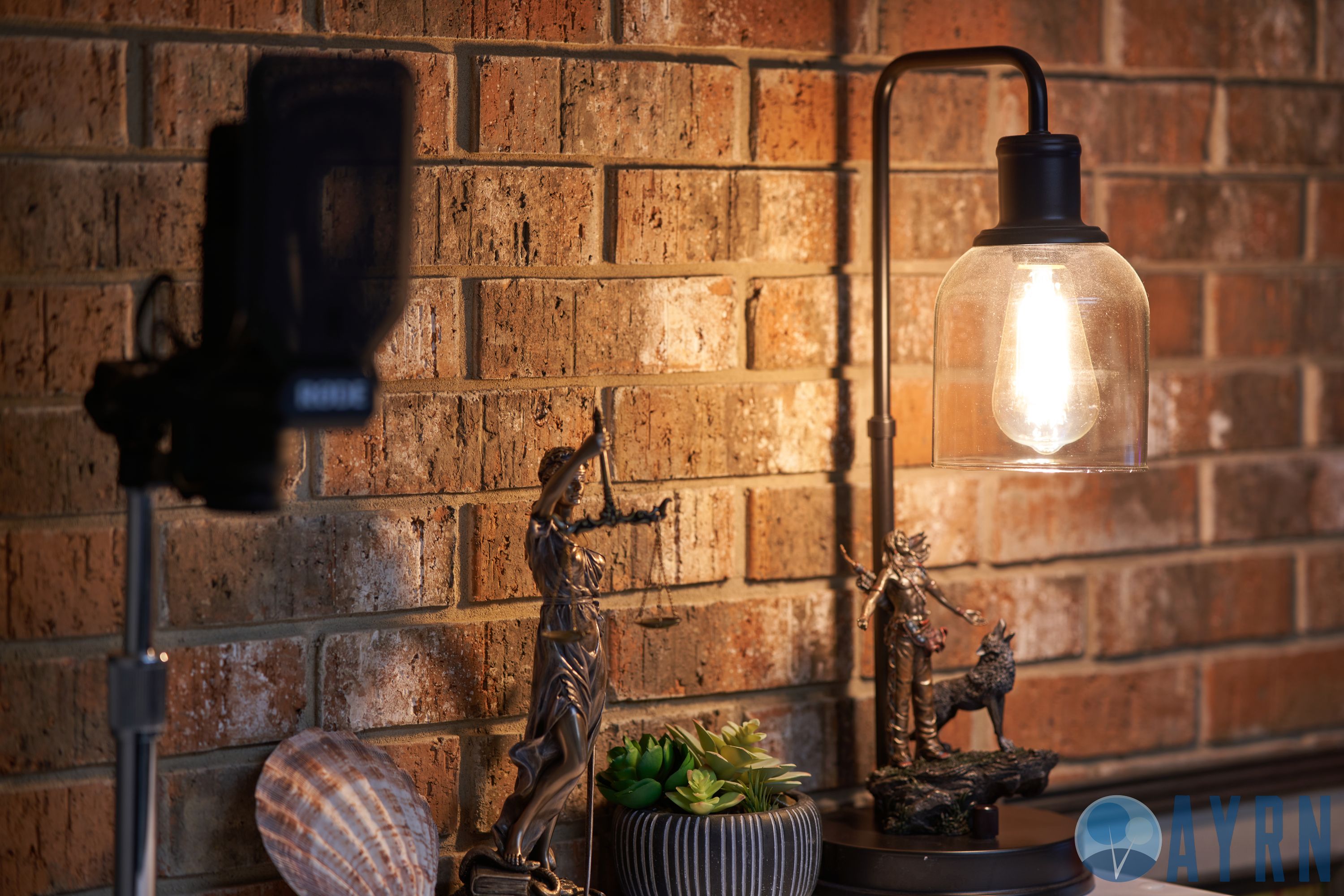



Sample image gallery
Aside from the images featured in this review, you can find ultra high definition sample images taken with this lens by visiting the gallery linked below.

AF 85mm f/1.4 bokeh
Whether you're the snobbiest of bokeh-snobs or someone just looking for some great subject isolation, this lens will deliver all you need and then some. I absolutely love the bokeh quality of this lens and that combined with the ultra sharp in-focus areas, makes for some real magic!

AF 85mm f/1.4 build quality
I think a lot of people have come to associate "good" build quality with something that essentially isn't plastic. In fact, lens manufacturers seem to be pretty aware of this and they've come up with terms like "rugged polycarbonate," "thermally stable composite," or "carbon fiber reinforced [...stuff]," which all more or less equate to "fancy plastic" as far as I can tell. In that sense, the Rokinon AF 85mm f/1.4 is made of the same stuff that most lenses on the market are made of, but it feels good in the hand and it has a nice minimalistic appearance. The weather sealing is a nice added touch, which not only helps protect the lens, but also the camera. In my experience, Samyang autofocus lenses tend to last about as long as other similarly priced lenses from reputable manufacturers, but their copy-to-copy variation hasn't been up to par with industry leaders. This means that experiences will vary as far as image quality goes.
Something worth mentioning here is that "build quality," when presented as being entirely about what the lens barrel is made out of, isn't a good indicator of how long a product is going to last. The fact that something feels heavy and is made out of titanium doesn't really give me any idea of when the internal electronic components will wear out and break down.
It's often an electronic component failing in newer lenses that will usher them through the pearly gates of camera paradise. Older manual focus lenses (plastic or otherwise) don't have internal electronics, so there's much less to go wrong with them and it's often much easier to fix problems when things do go wrong. Ergo, old manual focus lenses can last a hella long time. For example, I've got vintage manual focus Canon lenses that are about 50 years old, made pretty much entirely out of plastic, and they're still going strong.
Lots of old manual focus lenses are made of solid metal and glass - that's true. Just remember that juxtaposing that sort of reliability onto modern electronic lenses with similar barrel materials is definitely a false correlation that's bound to disappoint you.
One more thing to keep in mind is that having a metal barrel does nothing to prevent your lens from breaking if you drop it. Since lens elements are pretty much always made from glass, if you drop a lens, it's probably going to shatter - period. In fact, I'll play devil's advocate here and say that since plastic is better at absorbing impact than metal in most cases, and because plastic is typically a lot lighter than metal (think E = mc²), it wouldn't surprise me at all if plastic lenses generally have a better shot at surviving a fall than metal ones do. Don't get me wrong - I adore a well crafted metal lens, I really do, and I'm sure there are plenty of positive attributes to metal when it's implemented intelligently by companies with loads of lens making experience like Sigma, Zeiss, Sony, and Samyang. Just don't make it the end-all-be-all of choosing a new lens - that's all I'm saying.
P.S. if lens longevity is your top priority, consider getting a manual focus lens from a lens maker like Ziess, Voigtlander, or Rokinon's XP series or Mark ii manual focus lenses - they're really good. Otherwise, most good autofocus lenses will last you a long time anyway and you'll enjoy the added benefit of having vastly more in focus images. Just don't plan on passing them down to multiple generations of your family or anything.
AF 85mm f/1.4 autofocus performance
While not quite the fastest of all 85mm lenses for Sony that I've tested, considering that it's an extremely fast aperture lens, the Rokinon is right up there autofocus performance wise. It tends to struggle a bit in continuous mode during video shooting, but otherwise it felt effortless enough that I completely forgot about it during stills shooting.
AF 85mm f/1.4 feature breakdown
The Samyang 85mm f/1.4 AF is pretty minimal feature wise with the only things really worth mentioning being the 9 blade aperture, weather sealing (great touch in Samyang's part), and of course, it produces jaw droppingly gorgeous image quality. It's possible that last one might not really be a feature, but I feel like Samyang put everything into image quality so I dropped it here anyway. It's also got compatibility with all of Sony's focus modes, eyes autofocus works great, and for what it is, this lens is relatively light as a feather.
AF 85mm f/1.4 optical construction
At a glance, Samyang's lens construction looks fairly standard for an 85mm lens and the first four groups look remarkably similar to Sony's Zeiss Batis 85mm f/1.8, but after that, there's a good bit of deviation. While optical construction doesn't tell you everything about a lens or what it's capable of doing, I can tell you I found this formula to be highly effective in real world use.
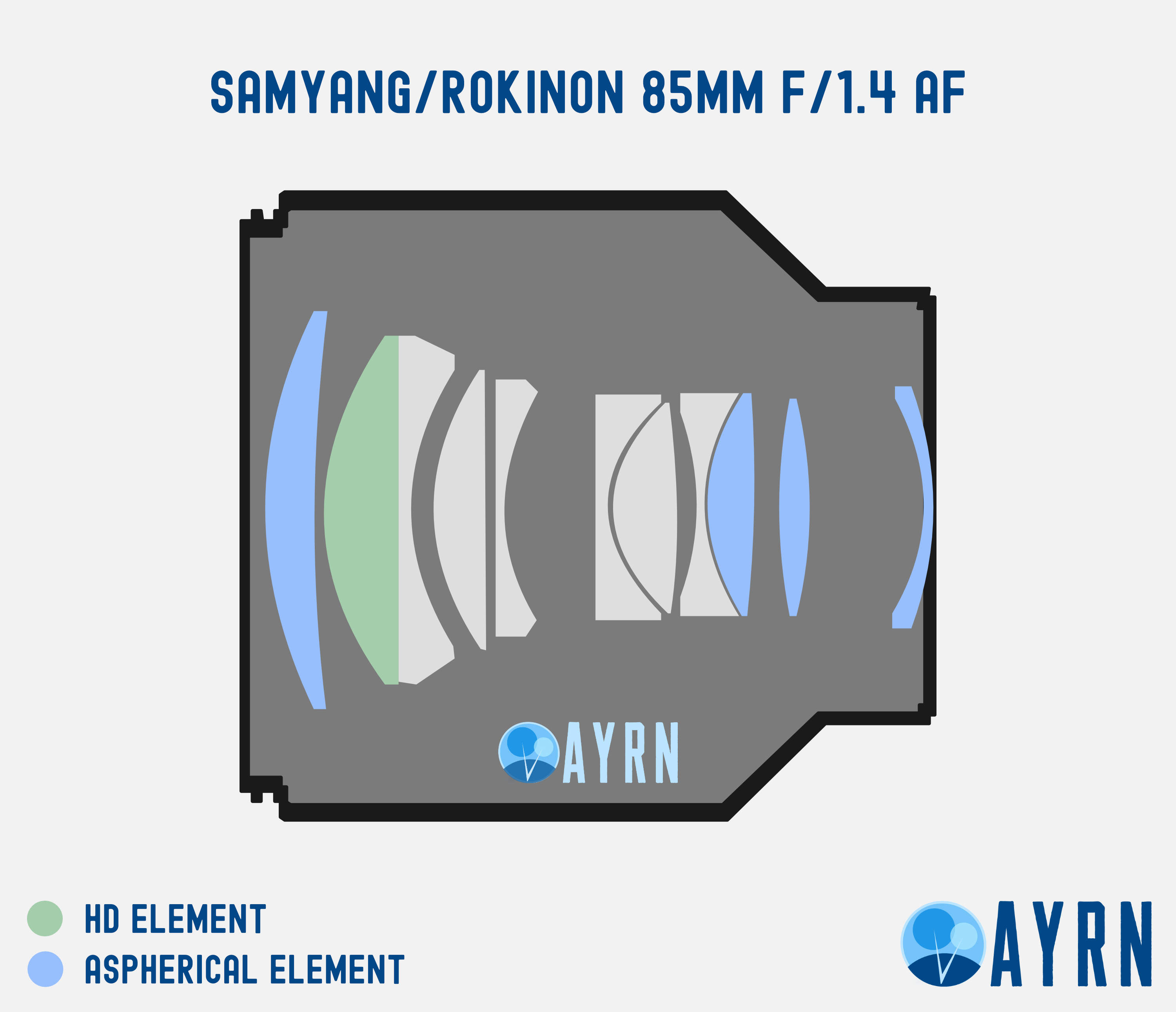
Ideas for improvement
- A physical switch for autofocus, like the one offered on the Nikon and Canon versions of Rokinon's 85mm AF lens would have been just swell.
- An aperture ring would have been nice, but certainly much less necessary than say - that autofocus on/off that I have on my wish list.
- An autofocus lock button would have been dandy, but again, not nearly as dandy as the on/off switch for autofocus would have been - that would have really put this lens over the top.
- A bit less jumpy autofocus in continuous mode for video would have been nice as well.


